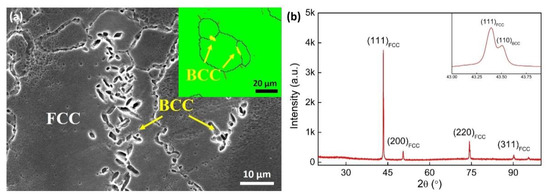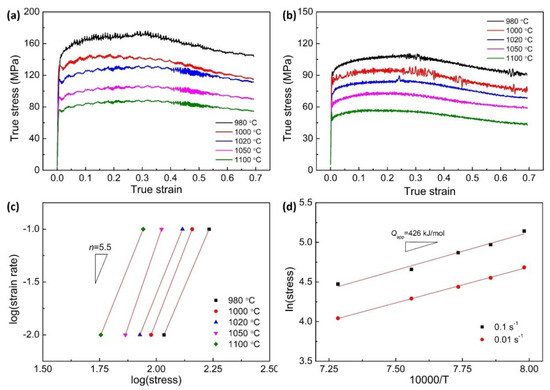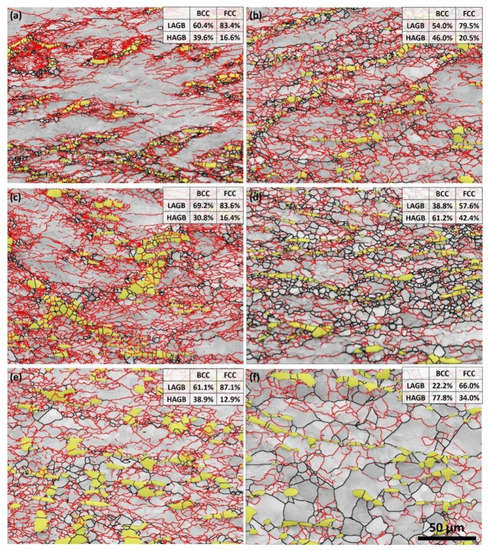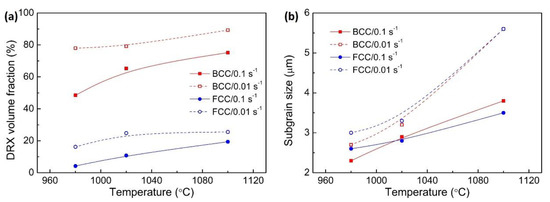Abstract
In this study, the flow behavior of a novel high entropy alloy, (FeNi)67Cr15Mn10Al5Ti3, was investigated through isothermal compression performed at temperature range of 980–1100 °C using strain rates of 0.01 s−1 and 0.1 s−1. The alloy was mainly composed of a face-centered cubic (FCC) phase and a small amount of body-centered cubic (BCC) phase. During deformation, the alloy exhibited typical single-peak type flow curve at all testing conditions. The stress exponent was determined to be ~5.5 with an apparent activation energy of ~426 kJ/mol, which indicated that dislocation creep was the rate-controlling process. Metallurgical inspection revealed that due to the plastic incompatibility of the two phases, the deformation is non-uniform especially at lower temperature and higher strain rate. Continuous dynamic recrystallization (CDRX) intensively occurred in both phases, but the recrystallization seemed to be much easier in the BCC phase. Dense low angle grain boundaries (LAGBs) were produced as a consequence of CDRX. At a lower strain rate, the LAGB ratio was evidently decreased with the increasing temperature. The sub-grain size was sensitive to the deformation parameter especially at a high temperature and low strain rate. A low temperature and high strain rate were beneficial for grain refinement but a much higher straining was required.
1. Introduction
High-entropy alloys (HEAs) have attracted intensive attentions in the recent decade because they encompass a wide range of microstructure and properties [1,2,3]. Moreover, the HEAs are among the most promising candidates to meet the increasing material demands of advanced applications. One of the major potential applications for HEAs is in the gas turbine industry due to their exceptional thermal stability, superior corrosion resistance, and high oxidation resistance [3,4]. More importantly, HEAs can retain the strength/hardness at elevated temperature with outstanding ductility/toughness [2,4]. This is offered by multiple hardening mechanisms such as secondary-phase strengthening, dislocation reactions, and solid solution strengthening. [2]. However, due to the heavy additions of solid solutes, sluggish diffusion, and complicated phase reactions, HEAs exhibit poor castability such that ingots being generally characterized by various defects including compositional segregation, coarse dendrites and casting porosity [5,6]. A thermomechanical processing route is therefore essential to achieve a refined, texture-mitigated, and segregation-free microstructure.
In recent years, the hot deformation behavior of HEAs has been paid increasing attention to examine their high-temperature formability as well as the governing deformation mechanisms. As prototypical HEAs, the deformation behavior of the CrMnFeCoNi-based alloys have been widely studied. Stepanov et al. [7] have studied the hot deformation behavior of the CrMnFeCoNi alloy at various temperatures and strain rates, and found that the stress exponent value ranged from 5.18 to 11.4 for temperatures of 1100–700 °C, and the apparent activation energy is in the range of 291–213 kJ/mol. The DRX initiated in shear bands or at grain boundaries depending on the deformation temperature. He et al. [8] studied the compressive flow behavior of the CrMnFeCoNi alloy and concluded that dislocation-climb is predominant at high strain rates and viscous glide at low strain rates. Jang et al. [9] have studied the hot tensile behavior of hot-rolled CrMnFeCoNi alloy, and they found that the grain size after recrystallization played a significant role in ductility and yield point phenomenon. Jeong et al. [4] have compared the deformation behavior of the CrMnFeCoNi and the Sn0.5CoCrFeMnNi alloy. Substantial differences were noted in flow stress and microstructure evolution. A solute-drag creep was predominant for CrMnFeCoNi alloy at low strain rates while the Sn adoption suppressed it. Kim et al. [10] have studied the hot deformation behavior of a dual-phase Al0.5CoCrFeMnNi alloy. The BCC phase invoked particle-stimulated-nucleation that induced DRX, resulting in a higher DRX fraction and a smaller DRX grain size than in the CoCrFeMnNi alloy.
Based on the abovementioned research status, one may note that hot deformation parameters as well as chemical compositions have a significant influence on flow behavior and microstructural evolution, which indicates that different HEAs require specifically designed hot-processing parameters to achieve the best ingot-breakdown efficiency. Based on the CrMnFeCoNi alloy, we previously proposed a HEA by removing Co element and adding some Al/Ti. The novel HEA alloy with a nominal composition of (FeNi)67Cr15Mn10Al5Ti3 exhibited superior mechanical properties after simple heat-treatments. In this study, we tried to examine the hot-workability of the alloy by analyzing the hot deformation behavior at typical processing conditions, i.e., temperature range of 980–1100 °C and strain rate range of 0.01–0.1 s−1. Emphasis was paid on the flow kinetics as well as the microstructural responses with deformation parameters.
2. Materials and Methods
The (FeNi)67Cr15Mn10Al5Ti3 HEA was prepared by induction skull melting (ISM) followed by vacuum arc remelting (VAR). An ingot with a raw dimension of Φ140 mm × 200 mm was obtained, and the actual composition is listed in Table 1. Isothermal compression was performed on a Gleeble-1500 thermomechanical simulator in vacuum atmosphere. To this end, samples with a dimension of Φ8 mm × 12 mm were machined from the ingot. The compression tests were performed at temperatures of 980, 1000, 1020, 1050 and 1100 °C with strain rates of 0.1 and 0.01 s−1. The samples were heated up to the target temperature with a rate of 10 °C/s and held for 5 min. After a height reduction of 50%, the samples were water-quenched to room temperature. During compression, the stress-strain data were automatically recorded.

Table 1.
Chemical composition of the present HEA.
The compressed samples were sectioned along the compression direction and mechanically ground for metallurgical analysis. The phase constituents were identified by X-ray diffraction (XRD), and the microstructure was analyzed on a Zeiss sigma500 scanning electron microscope (SEM) (Wofuben Precision Machinery Co., Ltd., Suzhou, China) under backscattered electron (BSE) mode. In order to obtain detailed microstructural information, electron backscattered diffraction (EBSD) was conducted using an accelerating voltage of 20 kV. A step size of 0.4 μm was applied to obtain microstructural details.
3. Results and Discussion
3.1. As-Cast Microstructure
The as-cast microstructure of the HEA is shown in Figure 1a. Note that it is different from the CrMnFeCoNi alloy which exhibits a single FCC (face-centered cubic) structure [11]. Many BCC (body-centered cubic) particles precipitated in the FCC matrix as well as along the grain boundaries, as indicated by the EBSD map. The XRD pattern shown in Figure 1b confirms this point, where a faint BCC peak can be differentiated [6]. In addition, one can observe that the microstructure of the FCC matrix is inhomogeneous so that the grain size is far from identical. Meanwhile, the distribution of the BCC particles is also non-uniform and forms clusters. The precipitates are rod like and most of them are 1–2 μm in diameter with a length of less than 10 μm. Such a microstructure is analogous to that of a FeCrNiMn medium entropy alloy proposed by Liu et al. [12]. The removal of Co element and the addition of Al/Ti may induce a transformation from the FCC to BCC phase [10].

Figure 1.
(a) Microstructure of the as-cast HEA. The inserted graph shows the EBSD phase map where the yellow color denotes the BCC phase; (b) XRD pattern of the HEA. The inserted graph shows the enlarged pattern between 43–44°.
3.2. Flow Behavior
The compressive flow curves at various conditions are shown in Figure 2a. Due to the low stacking-fault energy of HEAs [13], the strain-stress curves show a typical stress peak at a strain level around 0.2–0.3. After that, the flow stress is continuously decreased. In general, the hot deformation of metallic materials is thermally activated and can be described by the power-law equation or the hyperbolic-sine law [14]. Considering the relatively small temperature and strain rate range, here, we apply the power-law equation to model the deformation kinetics:
where Z is the Zenner-Hollomon parameter representing the temperature-corrected strain rate. σ and are the flow stress and strain rate, respectively. R is the gas constant and T is the absolute temperature. Qapp and n denote the apparent activation energy and stress exponent, respectively. A is a material constant. The most important parameters, n and Qapp, can be calculated by the following equations:
and

Figure 2.
Compressive flow curves at various temperatures under strain rates of (a) 0.1 s−1 and (b) 0.01 s−1. (c) Correlation between stress and strain in logarithmic scale; (d) Dependence of stress on temperature.
The logarithmic plot of strain rate against flow stress at various temperatures is shown in Figure 2c. One may note that at all temperatures the slope of the curves are roughly the same. Then, a mean stress exponent of ~5.5 can be derived in the testing temperature range. Such a stress exponent value is consistent with those of some other HEAs [4,15,16]. It is well known that when n ≈ 5, dislocation creep is responsible for the predominant deformation mechanism [14]. In this situation, the dislocation climb as the slower process is rate-controlling though a dislocation glide provides the major deformation.
The dependence of logarithmic flow stress on the inverse absolute temperature at two different strain rates is given in Figure 2d. A linear relationship is manifested for individual strain rate, while the slope of the two curves is roughly the same. According to Equation (3), the deformation apparent activation energy is estimated at 426 kJ/mol. Such a value is evidently higher than the self-diffusion energy of CrMnFeCoNi HEA (~284 kJ/mol) [17] as well as its Qapp values (290–350 kJ/mol) [7,8,16,18]. In contrast, the present activation energy is close to that of (FeCoNiCr)94Ti2Al4 (~420 kJ/mol) [18], Al0.3CoCrFeNi (394 kJ/mol) [16] and CrFeCoNiMo0.2 (463 kJ/mol) [19]. It may be supposed that the higher Qapp value of the present HEA is caused by the addition of Ti/Al elements.
3.3. Microstructure Evolution
The microstructure of the present HEA after deformation at various conditions is shown in Figure 3. When deformed at 980 °C/0.1 s−1, one can observe that the BCC rods are evidently elongated and rotated such that they tend to align perpendicular to the compression axis. Meanwhile, they are fragmentized and dense grain boundaries are produced. As for the FCC matrix, numerous low-angle grain boundaries (LAGBs) are also formed. However, most of the LAGBs are located around the BCC rods, whereas the LAGB density is much lower away from the rods.

Figure 3.
Band contrast maps for the alloy deformed at temperatures of (a,b) 980 °C, (c,d) 1020 °C and (e,f) 1100 °C, under strain rates of (a,c,e) 0.1 s−1 and (b,d,f) 0.01 s−1. The yellow regions denote the BCC phase. The high and low angle grain boundaries are superimposed using back and red lines, respectively.
As pointed out above, the deformation of the alloy is governed by a dislocation creep, which indicates that intensive glide/climb occurs. Due to the concurrent rotation and interaction between the BCC rods and FCC matrix, the strain concentration is much higher in the regions around the rods. Consequently, dense dislocations multiply/slip to accommodate the deformation incompatibility, and gradually arrange into sub-grain boundaries via a dislocation climb. In contrast, there are much fewer LAGBs inside of the FCC matrix, probably due to the long slip paths.
The temperature seems to have a slight effect on the LAGB/HAGB ratio at the strain rate of 0.1 s−1, as manifested by Figure 3a,c,e. However, metallographic inspection reveals that with the increasing temperature, the BCC rods are obviously spheroidized, and the distribution of grain boundaries are more homogeneous, which indicates a more uniform intragranular deformation. Meanwhile, the density of grain boundaries is dramatically decreased due to the increasing sub-grains sizes. In addition, it should be noted that the volume fraction of BCC phase is notably increased from 7% up to 14% with temperature increase. This may be driven by phase equilibrium at different temperatures. Similar results have also been noted in a Al0.5CoCrFeMnNi whose BCC fraction was increased from 6.3% at 950 °C up to 15.3% at 1200 °C during isothermal compression [20].
The temperature effect is much more evident at a strain rate of 0.01 s−1, as shown in Figure 3b,d,f. The ratio of HAGB is increased from 46% up to 78% for the BCC phase, and from 20% to 40% for the matrix. One may note that there is an abnormal reduction of HAGB ratio at 1100 °C. This is supposed to be caused by the dramatically decreased grain boundary density at the highest temperature.
Based on the above observations, it can be concluded that intensive dynamic recrystallization (DRX) occurs during deformation. Moreover, the DRX of both the FCC and BCC phase is not caused by a traditional discontinuous mechanism (DDRX) due to the lack of heterogeneous nucleation stage. Instead, it is attributed to a continuous recrystallization (CDRX) or extend recovery mechanism [21]. In such a case, a stable sub-grain structure is formed firstly via dynamic recovery mechanism, while the misorientation gradually increases through the accumulation of dislocations into the sub-boundaries [22]. This is evidenced by the high density of LAGB at all deformation conditions. Although it is generally accepted that DDRX is the major mechanism for alloys with a low stacking fault energy, it is also well-documented that some alloys can demonstrate either DDRX or CDRX under different deformation conditions, such as steels, magnesium alloys, and nickel alloys [23]. Jeong et al. [4] also reported that both DDRX and CDRX in the CoCrFeMnNi HEA, and the CDRX became more distinct as the temperature increased.
Because the CDRX occurs via an extend recovery manner [21], it requires sufficiently high intragranular straining to obtain full-DRX. This is demonstrated by the DRX volume fraction as shown in Figure 4a such that the DRX fraction of the FCC matrix is less than 30% at any deformation condition. However, the DRX is much more intensive in the BCC phase. It is ~50% at 980 °C/0.1 s−1, and reaches up to ~85% at 1100 °C/0.01 s−1. The higher DRX fraction of the BCC phase may originate from two aspects. Firstly, the BCC phase as the minority suffers from a complex strain history during straining, which can be manifested by the dramatic rotation of the rods. This would promote the multiple slip of dislocations and therefore is beneficial for the fragmentation of the rods. Secondly, the diffusion is much faster in the more open BCC structure than in the dense FCC matrix [24]. This may indicate that the BCC phase is softer under creep condition and carry larger deformation than the FCC matrix.

Figure 4.
(a) DRX volume fraction at various testing conditions; (b) The variation of sub-grain size at various conditions.
In the case of CDRX, the final grain size after full-DRX is determined by the stable sub-grain size [22]. Figure 4b shows the variation of the mean sub-grain size with the increasing temperature. By comparison, one can conclude that the sub-grain sizes of the BCC and FCC phases are nearly the same at the same deformation condition. Temperature has an evident effect on the sub-grain size, especially at a lower strain rate. Meanwhile, there is a negative effect of the strain rate on the sub-grain size, which is much more obvious at a high temperature. Given the fact that the DRX fraction is quite small in all conditions, a full-DRX can only be retained at sufficiently large straining.
4. Conclusions
This study aimed to reveal the flow characteristics of a novel high entropy alloy, (FeNi)67Cr15Mn10Al5Ti3, at a temperature range of 980–1100 °C and a strain rate range of 0.01–0.1 s−1. The main conclusions are drawn below.
- (1)
- The present high entropy alloy was mainly composed of the FCC phase, as well as a minor BCC phase appearing as micron-sized rods. During deformation, the alloy exhibited a typical single-peak type flow. The stress peak appeared around a strain level of 0.3, followed by continuous flow softening. The stress exponent was estimated to be 5.5, indicating a dislocation creep mechanism governing the deformation. The apparent activation energy of deformation was about 426 kJ/mol, which was close to those of other dual-phase high entropy alloys.
- (2)
- Due to the plastic incompatibility between the BCC rods and the FCC matrix, the deformation was localized around the BCC rods especially at a low temperature and high strain rate. Intensive CDRX occurred both in the BCC and FCC phase, and dense LAGBs were produced. At a lower strain rate, the LAGB ratio was obviously decreased with the increasing temperature, and this was more evident in the BCC phase. The sub-grain size was also sensitive to the deformation parameter, especially at a high temperature and low strain rate. A low temperature and high strain rate were beneficial for grain refinement but a higher straining was required.
Author Contributions
Conceptualization, J.M. and F.X.; methodology, J.M.; validation, F.X. and T.W.; formal analysis, Z.C.; investigation, N.W.; resources, X.X.; data curation, N.W.; writing—original draft preparation, N.W.; writing—review and editing, N.W.; project administration, T.W. All authors have read and agreed to the published version of the manuscript.
Funding
Nationl Natural Science Foundation of China-Young Fund Project (51901019)“Cavitation water jet impact surface strengthening and stress corrosion mitigation of nuclear power welded joints”.
Institutional Review Board Statement
The study did not involve humans or animals.
Informed Consent Statement
Not applicable.
Data Availability Statement
All authors agree that all experimental data of this study can be published.
Acknowledgments
The authors are grateful for the support provided by Nationl Natural Science Foundation of China-Young Fund Project(51901019) and Shanxi Key Laboratory of Advanced Metal Structural Materials Precision Thermoforming.
Conflicts of Interest
The authors declare no conflict of interest.
References
- Chen, J.; Zhou, X.; Wang, W.; Liu, B.; Lv, Y.; Yang, W.; Xu, D.; Liu, Y. A review on fundamental of high entropy alloys with promising high–temperature properties. J. Alloys Compd. 2018, 760, 15–30. [Google Scholar] [CrossRef]
- Sharma, P.; Dwivedi, V.K.; Dwivedi, S.P. Development of high entropy alloys: A review. Mater. Today Proc. 2021, 43, 502–509. [Google Scholar] [CrossRef]
- Murty, B.S.; Yeh, J.W.; Ranganathan, S.; Bhattacharjee, P.P. High-Entropy Alloys; Elsevier: Cham, Switzerland, 2019. [Google Scholar]
- Jeong, H.; Park, H.; Kim, W. Hot deformation behavior and processing map of a Sn0.5CoCrFeMnNi high entropy alloy with dual phases. Mater. Sci. Eng. A 2021, 801, 140394. [Google Scholar] [CrossRef]
- Lu, Y.; Dong, Y.; Jiang, H.; Wang, Z.; Cao, Z.; Guo, S.; Wang, T.; Li, T.; Liaw, P.K. Promising properties and future trend of eutectic high entropy alloys. Scr. Mater. 2020, 187, 202–209. [Google Scholar] [CrossRef]
- Wu, Q.; Wang, Z.; Zheng, T.; Chen, D.; Yang, Z.; Li, J.; Kai, J.-J.; Wang, J. A casting eutectic high entropy alloy with superior strength-ductility combination. Mater. Lett. 2019, 253, 268–271. [Google Scholar] [CrossRef]
- Stepanov, N.; Shaysultanov, D.; Yurchenko, N.; Zherebtsov, S.; Ladygin, A.; Salishchev, G.; Tikhonovsky, M. High temperature deformation behavior and dynamic recrystallization in CoCrFeNiMn high entropy alloy. Mater. Sci. Eng. A 2015, 636, 188–195. [Google Scholar] [CrossRef]
- He, J.; Zhu, C.; Zhou, D.; Liu, W.; Nieh, T.; Lu, Z. Steady state flow of the FeCoNiCrMn high entropy alloy at elevated temperatures. Intermetallics 2014, 55, 9–14. [Google Scholar] [CrossRef]
- Jang, M.J.; Praveen, S.; Sung, H.J.; Bae, J.W.; Moon, J.; Kim, H.S. High-temperature tensile deformation behavior of hot rolled CrMnFeCoNi high-entropy alloy. J. Alloys Compd. 2018, 730, 242–248. [Google Scholar] [CrossRef]
- Kim, W.; Jeong, H.; Park, H.; Park, K.; Na, T.; Choi, E. The effect of Al to high-temperature deformation mechanisms and processing maps of Al0.5CoCrFeMnNi high entropy alloy. J. Alloys Compd. 2019, 802, 152–165. [Google Scholar] [CrossRef]
- Ye, Y.; Wang, Q.; Lu, J.; Liu, C.; Yang, Y. High-entropy alloy: Challenges and prospects. Mater. Today 2016, 19, 349–362. [Google Scholar] [CrossRef]
- Liu, H.; Gu, C.; Zhai, K.; Wang, C. Strengthening and toughening the FeNiCrMn medium entropy alloy by novel ultrafine precipitate networks. Vacuum 2021, 184, 109995. [Google Scholar] [CrossRef]
- Reddy, S.R.; Sunkari, U.; Bhattacharjee, P.P. Recrystallization Behavior of High Entropy Alloys, Reference Module in Materials Science and Materials Engineering; Elsevier: Cham, Switzerland, 2021. [Google Scholar]
- Cheng, L.; Li, J.S.; Xue, X.Y.; Tang, B.; Kou, H.C.; Bouzy, E. General features of high temperature deformation kinetics for γ -TiAl-based alloys with DP/NG microstructures: Part I. A survey of mechanical data and development of unified rate-equations. Mater. Sci. Eng. A 2016, 678, 389–401. [Google Scholar] [CrossRef]
- Eleti, R.R.; Bhattacharjee, T.; Zhao, L.; Bhattacharjee, P.P.; Tsuji, N. Hot deformation behavior of CoCrFeMnNi FCC high entropy alloy. Mater. Chem. Phys. 2018, 210, 176–186. [Google Scholar] [CrossRef]
- Tong, Y.; Qiao, J.; Yao, Y. The constitutive model and threshold stress for characterizing the deformation mechanism of Al0.3CoCrFeNi high entropy alloy. Mater. Sci. Eng. A 2018, 730, 137–146. [Google Scholar] [CrossRef]
- Jeong, H.T.; Park, H.K.; Park, K.; Na, T.W.; Kim, W.J. High-temperature deformation mechanisms and processing maps of equiatomic CoCrFeMnNi high-entropy alloy. Mater. Sci. Eng. A 2019, 756, 528–537. [Google Scholar] [CrossRef]
- He, J.; Wang, H.; Wu, Y.; Liu, X.; Nieh, T.; Lu, Z. High-temperature plastic flow of a precipitation-hardened FeCoNiCr high entropy alloy. Mater. Sci. Eng. A 2017, 686, 34–40. [Google Scholar] [CrossRef]
- Wang, J.; Liu, Y.; Liu, B.; Wang, Y.; Cao, Y.; Li, T.; Zhou, R. Flow behavior and microstructures of powder metallurgical CrFeCoNiMo0.2 high entropy alloy during high temperature deformation. Mater. Sci. Eng. A 2017, 689, 233–242. [Google Scholar] [CrossRef]
- Jeong, H.; Kim, W. Calculation and construction of deformation mechanism maps and processing maps for CoCrFeMnNi and Al0.5CoCrFeMnNi high-entropy alloys. J. Alloys Compd. 2021, 869, 159256. [Google Scholar] [CrossRef]
- Doherty, R.; Hughes, D.; Humphreys, F.; Jonas, J.; Jensen, D.J.; Kassner, M.; King, W.; McNelley, T.; McQueen, H.; Rollett, A. Current issues in recrystallization: A review. Mater. Sci. Eng. A 1997, 238, 219–274. [Google Scholar] [CrossRef] [Green Version]
- Sakai, T.; Belyakov, A.; Kaibyshev, R.; Miura, H.; Jonas, J.J. Dynamic and post-dynamic recrystallization under hot, cold and severe plastic deformation conditions. Prog. Mater. Sci. 2014, 60, 130–207. [Google Scholar] [CrossRef] [Green Version]
- Zhang, H.; Xiao, H.; Fang, X.; Zhang, Q.; Logé, R.; Huang, K. A critical assessment of experimental investigation of dynamic recrystallization of metallic materials. Mater. Des. 2020, 193, 108873. [Google Scholar] [CrossRef]
- Cheng, L.; Li, J.S.; Xue, X.Y.; Tang, B.; Kou, H.C.; Perroud, O.; Bouzy, E. Effect of β /B2 phase on cavitation behavior during superplastic deformation of TiAl alloys. J. Alloys Compd. 2017, 693, 749–759. [Google Scholar] [CrossRef]
Publisher’s Note: MDPI stays neutral with regard to jurisdictional claims in published maps and institutional affiliations. |
© 2022 by the authors. Licensee MDPI, Basel, Switzerland. This article is an open access article distributed under the terms and conditions of the Creative Commons Attribution (CC BY) license (https://creativecommons.org/licenses/by/4.0/).